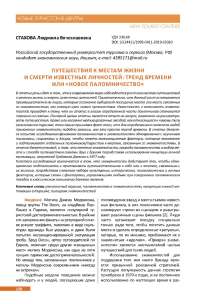Путешествия к местам жизни и смерти известных личностей: тренд времени или "новое паломничество"
Автор: Стахова Людмила Вячеславовна
Журнал: Современные проблемы сервиса и туризма @spst
Рубрика: Новые туристские центры
Статья в выпуске: 3 т.13, 2019 года.
Бесплатный доступ
В статье речь идет о том, что в современном мире наблюдается рост количества путешествий к местам жизни и смерти известных личностей. Примечательно, что данный рост основывается преимущественно на лицах, которые осознанно выбирают посещение места или мест, связанных со знаменитостью, как главную цель своего путешествия. Известность и значимость знаменитостей приводят к тому, что их статус в глазах определенной части поклонников становится похожим на святых. Основной целью статьи является ответ на вопрос, возможно ли рассматривать путешествия, прямо или косвенно мотивированные звездой, как относящиеся к новому типу религиозного туризма, тем самым признавая факт того, что для определенного сегмента людей поклонение знаменитости подобно религии, или это просто тренд времени. В статье делается попытка исследования феномена паломничества к знаменитостям одновременно с изучением психологии, социологии и досуга, чтобы понять мотивационные факторы, которые вовлекают и подталкивают отдельных паломников/туристов к местам, связанным со знаменитостями...
Религиозный туризм, паломничество к знаменитостям, концепция личной мотивации в туризме, пилигрим знаменитостей
Короткий адрес: https://sciup.org/140244587
IDR: 140244587 | DOI: 10.24411/1995-0411-2019-10310
Список литературы Путешествия к местам жизни и смерти известных личностей: тренд времени или "новое паломничество"
- Badone, E., & Roseman,S. R. (Ed.). (2004).Approaches to the Anthropology of Pilgrimage and Tourism. In: Inter-secting Journeys: The Anthropology of Pilgrimage and Tourism, 1-23. Chicago: University of Illinois Press.
- Beeton, S. (2005). Film-Induced Tourism. Clevedon: Channel View Publications.
- Berger, P. (1967). The Social Reality of Religion. London: Faber.
- Boorstin, D. J. (1963). The Image: Or, What Happened to the American Dream. Harmondsworth, Middlesex: Penguin.
- Boorstin, D. J. (2006). From Hero to Celebrity: The Human Pseudo-Event. In: The Celebrity Culture Reader, by P. D. Marshall (Ed.), 73-90.
- Brooks, D. (2000). Bobos in Paradise: The New Upperclass and How They Got There. New York: Simon
- Brown, P. R. L. (1981). The Cult of the Saints: Its Rise and Function in Latin Christianity. Chicago: University of Chicago Press.
- Cashmore, E. (2006). Celebrity/Culture. Abingdon: Routledge.
- Collins-Kreiner, N. (2010). Researching pilgrimage: Continuity and Transformations. Annals of Tourism Research, 37(2), 440-456.
- DOI: 10.1016/j.annals.2009.10.016
- Dann, Graham M. S. (1977). Anomie, Ego-Enhancement and Tourism. Annals of Tourism Research, 4(4), 184-194.
- DOI: 10.1016/0160-7383(77)90037-8
- Demerath, N. J. (2000). The Varieties of Sacred Experience: Finding the Sacred in a Secular Grove. Journal for the Scientific Study of Religion, 39(1), 1-11.
- DOI: 10.1111/0021-8294.00001
- Digance, J. (2003). Pilgrimage at Contested Sites. Annals of Tourism Research, 30(1), 143-159.
- DOI: 10.1016/S0160-7383(02)00028-2
- Digance, J. (2006). Religious and Secular Pilgrimage: Journeys Redolent with Meaning. In: Tourism, Religion and Spiritual Journeys, by J. Dallen
- Frey, N. L. (1998). Pilgrim Stories: On and Off the Road to Santiago. Berkeley: University of California Press.
- Goffman, E. (1959). The Presentation of Self in Everyday Life. New York: Anchor Books for Doubleday.
- Graburn, Nelson H.H. (1989). Tourism: The Sacred Journey. In: Hosts and Guests: The Anthropology of Tourism, by V. L. Smith (Ed.). Philadelphia: University of Pennsylvania Press, 21-36.
- Hahn, C. (1997). Seeing and Believing: The Construction of Sanctity in Early Medieval Saints' Shrines. Speculum, 72(4), 1079-1106.
- DOI: 10.2307/2865959
- Heelas, P. (1996). The New Age Movement: The Celebration of the Self and the Sacralization of Modernity. Oxford: Blackwell.
- Ingham, R. (1987). Psychological contributions to the study of leisure - Part Two. Leisure Studies, 6(1), 1-14.
- DOI: 10.1080/02614368700390011
- Laverie, D. A., & Dennis, B. (2000).Arnett Factors Affecting Fan Attendance: The Influence of Identity Salience and Satisfaction. Journal of Leisure Research, 32(2), 225-246.
- Lee, S., Scott, D., & Hyounggon, K. (2008). Celebrity fan involvement and destination perceptions. Annals of Tour-ism Research, 35(3), 809-832.
- Lyon, D. (2000). Jesus in Disneyland: Religion in Postmodern Times. Cambridge: Polity Press.
- Maltby, J., McCutcheon, L. E., Ashe, D. D., & Houran, J. (2001). The Self-Reported Psychological Well-Being of Celebrity Worshippers. North American Journal of Psychology, 3(3), 441-452.
- Marshall, P. D. (1997). Celebrity and Power: Fame in Contemporary Culture. Minneapolis: University of Minnesota Press.
- DOI: 10.5749/j.ctt7zw6qj
- McCracken, G. (1989). Who is the Celebrity Endorser? Cultural foundations of the Endorsement Process. Journal of Consumer Research, 16(3), 310-321.
- McCutcheon, L., Lange, R., & Houran,J. (2002). Conceptualization and Measurement of Celebrity Worship. British Journal of Psychology, 93, 67-87.
- Stebbins, R. (1982). Serious Leisure: A Conceptual Statement. Pacific Sociological Review, 25(2), 251-272.
- DOI: 10.2307/1388726
- Stever, G. S. (1991). The Celebrity Appeal Questionnaire. Psychological Reports, 68, 859-866. 10.2466 / PR0.68.3.859-866.
- DOI: 10.2466/PR0.68.3.859-866
- Taylor, C. (2017). Secular Age. Cambridge, MA: Belknap Press of Harvard University Press.
- Turner, V. (1973). The Center Out There: Pilgrim's Goal. History of Religions, 12(3), 191-230.
- Turner, V. W., & Turner,E. (1976).Image and Pilgrimage in Christian Culture: Anthropological Perspectives. New York: Columbia University Press
- Wann, D. (1995). Preliminary Validation of the Sport Fan Motivation Scale. Journal of Sport
- Weber, M. (2016). The Sociology of Charismatic Authority. In: The Celebrity Culture Reader, by P. David Marshall (Ed.). New York: Routledge, 55-71.


